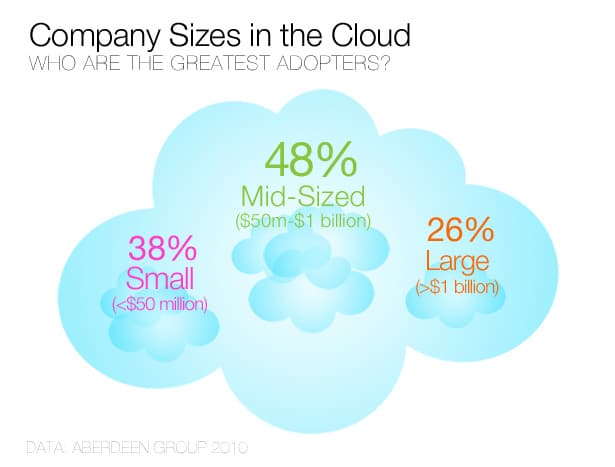08-23-11 | Blog Post
A recent survey conducted by the Aberdeen Group uncovered the IT disaster recovery trends of a range of companies using cloud computing for data storage, backup and recovery. Comparing cloud users and non-cloud users, they found that mid-sized companies ($50 million to $1 billion of yearly revenue) were the largest group to adopt the cloud for data storage, accounting for 48 percent of the cloud users surveyed. Small companies (under $50 million of yearly revenue) were next at 38 percent and large companies (above $1 billion of yearly revenue) came in last at only 26 percent.

Along with the highest use of cloud computing, mid-sized businesses also made out with the shortest recovery times – the average length of time per disaster recovery event lasted 4 hours, while large companies, with the least percentage of cloud adoption, endured 7.7 hours.

Comparing overall cloud users to non-cloud users (as seen above), the average length of downtime per disaster recovery event was 8 hours for non-cloud users, and 2.1 hours by cloud user standards (nearly four times faster). What could account for the time disparity? Non-cloud users may depend on traditional and time-consuming tape backup methods with complex recovery paths for their disaster recovery plan. Companies that use cloud computing for disaster recovery benefit from the elimination of tape backup, offsite tape backup and cold site DR, making for faster online backup and recovery times.
Cloud users also experienced an improvement in number of downtime events over the past year, decreasing 9 percent, while non-cloud users decreased only 4.7 percent.

So what drove them to the cloud (above)? The top business driver behind cloud computing initiatives was the need for disaster recovery or a backup solution, as reported by 66 percent of those surveyed. As entire record systems move to electronic systems, greater dependence on the uptime and availability of applications and data means the demand for faster and accurate recovery is growing. Cloud computing can deliver both, making it the most efficient method for a disaster recovery plan.
Another decider was the need to manage escalating IT infrastructure costs (55 percent). Forty-six percent required the capability to support additional users or services, while 38 percent needed to manage the escalating complexity of their IT infrastructure.
The survey shows overall faster average recovery times and an improved rate of downtime events with mid-sized companies leading the way in adopting cloud computing as a data storage method. Although large companies often build their own data centers with diverse locations, their adoption of cloud computing is likely to trend upward as IT costs and the need for data storage and efficient disaster recovery plans increase.
Read more about our related blog posts on Disaster Recovery and Cloud Computing.